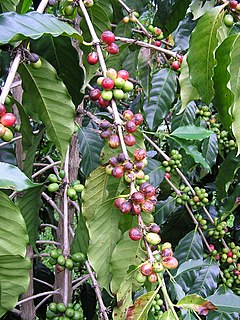
Cercospora is a genus of ascomycete fungi. Most species have no known sexual stage, and when the sexual stage is identified, it is in the genus Mycosphaerella. Most species of this genus cause plant diseases, and form leaf spots. It is a relatively well-studied genus of fungus, but there are countless species not yet described, and there is still much to learn about the best-known of the species.

Mycosphaerella coffeicola is a sexually reproducing fungal plant pathogen. It is most commonly referred to as the asexual organism Cercospora coffeicola.
Cercospora apii f.sp. clerodendri is a fungal plant pathogen.
Cercospora arachidicola is a fungal ascomycete plant pathogen that causes early leaf spot of peanut. Peanuts originated in South America and are cultivated globally in warm, temperate and tropical regions.

Cercospora beticola is a fungal plant pathogen which typically infects plants of the genus Beta, within the family of Chenopodiaceae. It is the cause of Cercospora leaf spot disease in sugar beets, spinach and swiss chard. Of these hosts, Cercospora leaf spot is the most economically impactful in sugar beets. Cercospora beticola is a deuteromycete fungus that reproduces using conidia. There is no teleomorph stage. C. beticola is a necrotrophic fungus that uses phytotoxins specifically Cercospora beticola toxin (CBT) to kill infected plants. CBT causes the leaf spot symptom and prevents root formation. Yield losses from Cercospora leaf spot are around 20 percent.
Cercospora rosicola is a fungal plant pathogen.
Cercospora sorghi is a fungal plant pathogen.
Mycosphaerella cruenta, also called Pseudocercosopora cruenta in its asexual stage, is a fungal plant pathogen belonging to the group Ascomycota. It can affect several legume plants, including species of Phaseolus, Vigna, Calopogonium, Lablab niger, Mucuna and Stizolobium deeringianum [Mucuna pruriens][2]. It causes cowpea cercospora leaf spot, one of the most widespread and significant plant diseases in Africa and Asia. A city in China reported a 100% Mycosphaerella cruenta infection rate on cowpea in 2014[5]. In Africa, an epidemic can cause a yield loss of up to 40% [3].
Mycosphaerella henningsii is a fungal plant pathogen that causes Brown leaf spot (BLS) in cassava).Part
Pseudocercospora puderi is a fungal plant pathogen infecting roses.
Sphaerulina oryzina is a fungal plant pathogen infecting rice. Propiconazole is an effective fungicide recommended for use in rice culture.

Cercospora sojina is a fungal plant pathogen which causes frogeye leaf spot of soybeans. Frog eye leaf spot is a major disease on soybeans in the southern U.S. and has recently started to expand into the northern U.S. where soybeans are grown. The disease is also found in other soybean production areas of the world.
Cercospora gerberae is a fungal plant pathogen.
Cercospora kikuchii is a fungal plant pathogen that affects soybeans. It results in both the Cercospora leaf blight and purple seed stain diseases on soybean and is found almost worldwide. C. kikuchii produces the toxin cercosporin, as do a number of other Cercospora species.

Cercospora melongenae is a fungal plant pathogen that causes leaf spot on eggplant. It is a deuteromycete fungus that is primarily confined to eggplant species. Some other host species are Solanum aethiopicum and Solanum incanum. This plant pathogen only attacks leaves of eggplants and not the fruit. It is fairly common among the fungi that infect community gardens and home gardens of eggplant. Generally speaking, Cercospora melongenae attacks all local varieties of eggplants, but is most severe on the Philippine eggplant and less parasitic on a Siamese variety.
Cercospora apiicola is a fungal plant pathogen, who causes leaf spot on celery.

Grey leaf spot (GLS) is a foliar fungal disease that affects maize, also known as corn. GLS is considered one of the most significant yield-limiting diseases of corn worldwide. There are two fungal pathogens that cause GLS: Cercospora zeae-maydis and Cercospora zeina. Symptoms seen on corn include leaf lesions, discoloration (chlorosis), and foliar blight. Distinct symptoms of GLS are rectangular, brown to gray necrotic lesions that run parallel to the leaf, spanning the spaces between the secondary leaf veins. The fungus survives in the debris of topsoil and infects healthy crop via asexual spores called conidia. Environmental conditions that best suit infection and growth include moist, humid, and warm climates. Poor airflow, low sunlight, overcrowding, improper soil nutrient and irrigation management, and poor soil drainage can all contribute to the propagation of the disease. Management techniques include crop resistance, crop rotation, residue management, use of fungicides, and weed control. The purpose of disease management is to prevent the amount of secondary disease cycles as well as to protect leaf area from damage prior to grain formation. Corn grey leaf spot is an important disease of corn production in the United States, economically significant throughout the Midwest and Mid-Atlantic regions. However, it is also prevalent in Africa, Central America, China, Europe, India, Mexico, the Philippines, northern South America, and Southeast Asia. The teleomorph of Cercospora zeae-maydis is assumed to be Mycosphaerella sp.
The Australian Plant Census (APC) provides an online interface to currently accepted, published, scientific names of the vascular flora of Australia, as one of the output interfaces of the national government Integrated Biodiversity Information System. The Australian National Herbarium, Australian National Botanic Gardens, Australian Biological Resources Study and the Council of Heads of Australasian Herbaria coordinate the system.
Apii Nicholls-Pualau is a New Zealand rugby league footballer who played for the New Zealand Warriors in the NRL Women's Premiership.
C. theae can refer to a few different species (below). The specific epithet theae refers to tea, and many of the below are pathogens of the tea plant.






